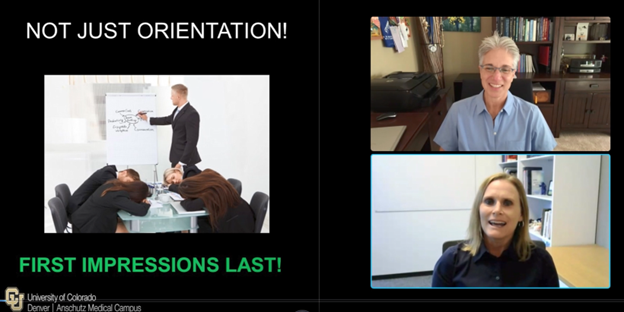Are you experiencing challenges onboarding new lab animal professionals? With recent staffing shortages, onboarding and training new employees effectively is critical. Here are some tips on how to properly onboard, train, and release new employees, according to Jori K. Leszczynski, DVM, DACLAM.
In our recent webinar series, “Strategies to Improve Personnel Management,” Leszczynski dives into topics surrounding management in the lab animal field. She explains just how important the onboarding process is. It can be a way to make an impactful first impression on new employees. Furthermore, it can set the tone of your expectations and competence as a facility. And if you’re not creating an engaging, positive work environment from the beginning — you might miss the mark.

For example, if you onboard someone correctly, it can improve retention by 82%. Furthermore, only 12% of people agree onboarding at their new job was good. So, how can you improve your onboarding process? Here are some of Leszczynski’s tips for an onboarding process that will result in well-trained and long-lasting employees.
Effectively Communicate with New Lab Animal Professionals Before They Start
According to Leszczynski, the onboarding process for new employees should start way before their first day on the job. Communicating with them before the first day is a fantastic way to set them up for success. Leszczynski calls this phase the pre-start phase.
What topics should you be covering during the pre-start phase? It might sound simple, but make sure they know what day and time to arrive for their first day. Also, give clear instructions on where they should park. Then, ensure they have detailed directions about how to get to your office. Remember, for many new employees, the first day of work might be the first time they have entered your facility.
Additionally, give them a general idea of how the first day/week will look. For example, if their role is mainly paperwork, ensure they know. Also, you should fill them in on what to wear and what to bring with them on the first day.
These simple steps can make a lasting impression on new hires. The pre-start phase is probably the quickest phase when onboarding a new employee. But it’s critical to ensure your new employee has a fantastic first impression.
Cover the Basics in the First Week of Onboarding Lab Animal Professionals
The first week is critical for a new employee’s onboarding process. According to Leszczynski, there are a few things that you should have prepared and ready within the first week of onboarding a new employee. First, ensure you have a designated greeter or contact person to welcome them, to show you’re expecting them.
Second, be prepared to give them access to the building and their computer. Why? One of the biggest causes of discontent among new employees is they don’t have physical access. Make appointments for badges and keys ahead of time! That way, you can set up your new employee with physical access during their first week. Imagine how discouraged a new employee would feel if they couldn’t access the bathroom because they didn’t have a working badge yet.

Third, Leszczynski recommends giving them a full tour of the facility during their first week. It will demonstrate the breadth and scope of your workplace. It will also help them to understand where to find work supplies.
Next, make sure they are assigned their initial training tasks. For example, have them view training videos and complete online modules. Leszczynski encourages having people come in-person, around other people, for initial training. It invites them to ask more questions.
Then, give them some real experience! Let them begin some work tasks with help and supervision. Then they can understand how the job will be. Lastly, it’s critical to show them you care. When they ask questions, reply with a smile. Let them know they are welcome.
Make The Training Process Intentional
The third phase is the training process. Leszczynski explains that you should not rush the training phase. For training to be effective and long-lasting, you have to take your time, set intentions, and have a plan. For example, training takes 2-6 months at Leszczynski’s facility.
Furthermore, Leszczynski recommends documenting all aspects of the training process. It’s critical to track the progress of new employees to keep them, and you, accountable. Plus, their supervisor should frequently check in with them to confirm they’re comfortable and making progress. Imagine how welcome employees will feel if their supervisor takes the time to check in on their progress.
Utilize Checklists for Optimized Success in Training New Lab Animal Professionals
Creating systems for organization and accountability is imperative to any successful operation, especially in the lab animal science field. According to Leszczynski, the checklist is the way to go. Especially when onboarding and training new staff.
She recommends The Checklist Manifesto by Atul Gawande. Gawande is a Doctor of Medicine interested in medical errors and why they happen. He found that groups that used checklists had significantly fewer errors.
Why do checklists work? Because as people become more familiar with complex tasks, they tend to take shortcuts. It’s alarming because taking shortcuts while completing complex tasks in the medical field can produce tragic results.
Multiple Trainers Can Enrich the Training Process for New Hires
Next, Leszczynski finds using multiple trainers is beneficial for new employees. First of all, it encourages new hires to socialize with the group. Rather than just meeting one individual and training with them all week, they get to know more people. Plus, it’s an excellent opportunity for more staff members to be trainers. Employees who train new staff develop a deeper understanding of their teaching topics.
Furthermore, it allows new employees to see multiple strategies for doing specific tasks. Also, it’s a fantastic opportunity for the trainer. Of course, there are standards for each job in a lab animal facility, but there’s room for variation in these standards. For example, maybe one team member changes cages from top to bottom on a rack while another goes from right to left. It’s great to expose new staff to multiple strategies, so they can decide what works best for them. Just remember, go at the employee’s pace. Don’t force or rush them.
Lastly, it’s critical to follow up during training. Leszczynski suggests following up 3-4 weeks into training and then at the end of training. The reason it’s imperative to follow up within 3-4 weeks is you want to find out early if something is going wrong with the training before it’s too late to correct it.
Release New Employees to Begin Working
The final phase is to release the employee from the training phase. Leszczynski explains that it’s critical to have clear indicators of when an employee has completed training. In her facility, they release employees once they finish the training check sheet and pass a quiz to make sure that any areas that are not clean can be reinforced with additional training.
Lastly, don’t forget to collect feedback. Offer new employees the opportunity to rate their experience training in your facility. Receiving employee feedback can help you improve your program. Also, when new employees see that you value their feedback, it can help set the tone about your facility. Then, they will be more likely to come forward with suggestions and feedback in the future.
More from Our Webinar: How to Foster Active Accountability
Most employers would agree that active accountability is more favorable than passive accountability. According to Leszczynski, the onboarding phase is the best time to introduce habits that produce actively accountable employees.
Watch our Webinar Now to Learn More
To learn more about ways to improve personnel management in the lab animal facility, view our webinar, “Strategies to Improve Personnel Management,” with speakers Jori K. Leszczynski, DVM, DACLAM, and Cindy Buckmaster, PhD, CMAR, RLTAG.

